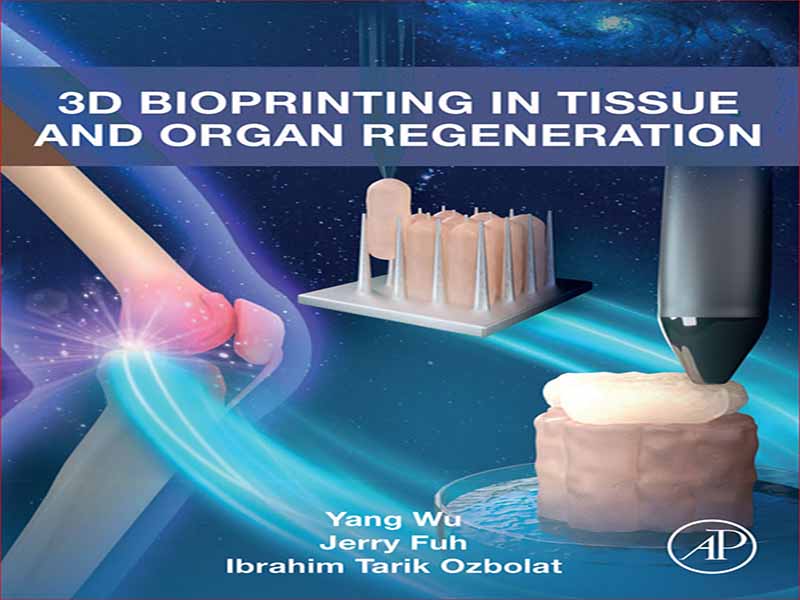- عنوان کتاب: 3D Bioprinting in Tissue and Organ Regeneration
- نویسنده: Yang Wu, Jerry Fuh, Ibrahim Tarik Ozbolat
- حوزه: پرینت سه بعدی
- سال انتشار: 2022
- تعداد صفحه: 308
- زیان اصلی: انگلیسی
- نوع فایل: pdf
- حجم فایل: 4.83 مگابایت
چاپ زیستی سه بعدی (سه بعدی) استفاده از روش های لایه به لایه برای رسوب جوهرهای زیستی مانند سلول ها، فاکتورهای رشد و مواد زیستی برای ساخت قطعات زیست پزشکی است که حداکثر ویژگی های بافت/ اندام طبیعی را تقلید می کند. در دهه گذشته، چاپ زیستی به طور قابل توجهی پیشرفت کرده است و تعداد زیادی از مطالعات نتایج جذابی را در کاربردهای مختلف نشان دادهاند. پیشبینی میشود که بازار پرینت زیستی سه بعدی تا سال 2024 به 1647.4 میلیون دلار برسد. در این راستا، توسعه یک کتاب جامع که پیشرفتهای پیشرفته در کاربردهای چاپ زیستی را پوشش میدهد برای دانشگاه، عموم و صنعت ارزشمند است. این کتاب در سه بخش اصلی سازماندهی شده است و به خوانندگان کمک می کند تا چاپ زیستی را از زوایای مختلف درک کنند. اول از همه، این کتاب شامل یک بحث جامع است که ملاحظات اصلی را در مراحل پیش از چاپ زیستی، چاپ زیستی و پس از چاپ زیستی پوشش می دهد، که به خوانندگان یک دید کلی برای درک فرآیند فنی طراحی و ساخت یک محصول زیست چاپی می دهد. ثانیاً، بخش عمده ای از این کتاب توضیحات مفصلی از کاربردهای مختلف چاپ زیستی، از جمله پوست، غضروف، استخوان، بافت عروقی و اندام ها را پوشش می دهد، که به مهندسان زیستی، مهندسین تولید و پزشکان کمک می کند تا رویکردهای ساخت زیستی بافت مورد نظر را درک کنند. نوع اندام، مانند انتخاب بیوئینک، نوع چاپگر زیستی و فرآیند مناسب. به خصوص چاپ زیستی حین عمل در فصلی جداگانه برجسته شده است که به طور گسترده به عنوان یکی از روندهای مهم آینده چاپ زیستی مورد توجه قرار گرفته است. در نهایت، نگرانی های اخلاقی و نظارتی در مورد استفاده بالینی از چاپ زیستی نیز مورد بحث قرار خواهد گرفت، که بینشی منحصر به فرد از مسئولیت اجتماعی محققان و پزشکان در این زمینه را به خواننده ارائه می دهد. به طور کلی، در مقایسه با کتابهای فعلی که عمدتاً بر روی تکنیکهای چاپ زیستی تمرکز دارند، این کتاب بیشتر کاربردیمحور است و ارزش بالای چاپ زیستی را به مخاطب نشان میدهد. این کتاب یک منبع عالی برای دانشجویان ارشد و کارشناسی ارشد است که به چاپ زیستی علاقه مند هستند و توصیه می شود به عنوان کتاب درسی برای دروس مرتبط با چاپ زیستی استفاده شود. این کتاب می تواند نقش آموزنده ای در توسعه محصولات پزشکی با استفاده از چاپ زیستی برای متخصصان صنعت داشته باشد. محققان رشته های مهندسی پزشکی، مهندسی مکانیک و پزشکی می توانند برای اطلاع از آخرین پیشرفت ها در این زمینه به این کتاب مراجعه کنند.
Three-dimensional (3D) bioprinting is the utilization of layer-by-layer methods to deposit bioinks such as cells, growth factors, and biomaterials to fabricate biomedical parts that maximally imitate natural tissue/organ characteristics. In the past decade, bioprinting has considerably advanced and a large number of studies have shown attractive outcomes in different applications. The 3D bioprinting market is projected to reach USD 1647.4 million by 2024. This burgeoning technology appears promising for evolving tissue engineering toward functional tissue and organ regeneration, ultimately alleviating organ shortage. In this regard, the development of a comprehensive book covering the state-of-the-art advance in applications of bioprinting is valuable for academia, the public, and industry. This book is organized into three major parts, and it benefits the readers to understand bioprinting from varied angles. First of all, this book contains a comprehensive discussion, covering the major considerations during the prebioprinting, bioprinting, and postbioprinting stages, which gives the readers an overview to understand the technical process of designing and manufacturing a bioprinted product. Secondly, a major portion of this book covers detailed descriptions of different applications of bioprinting, including skin, cartilage, bone, vascularized tissue, and organs, which helps the bioengineers, manufacturing engineers, and clinicians to understand the biofabrication approaches of the given tissue/organ type, such as the selections of bioink, bioprinter type, and appropriate process. Especially, intraoperative bioprinting is highlighted in a separate chapter, which has been widely considered as one of the important future trends of bioprinting. Lastly, ethical and regulatory concerns about the clinical utilization of bioprinting will also be discussed, which offers the reader a unique insight into the social responsibility of researchers and practitioners in this field. Overall, compared to current books that largely focus on bioprinting techniques, this book is more application-oriented, showing the audience the great value of bioprinting. This book is a great source for senior undergraduate and graduate students who are interested in bioprinting and is recommended to be used as a textbook for bioprinting-related courses. This book could play an instructive role in developing medical products using bioprinting for industry professionals. Researchers in the disciplines of biomedical engineering, mechanical engineering, and medicine can refer to this book for the latest advance in this field.
این کتاب را میتوانید بصورت رایگان از لینک زیر دانلود نمایید.
































نظرات کاربران